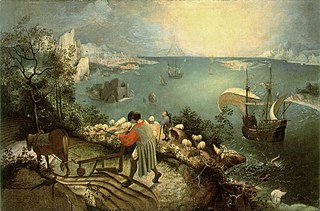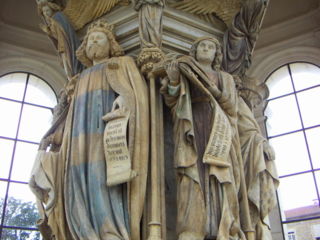 W
WThe Northern Renaissance was the Renaissance that occurred in Europe north of the Alps. From the last years of the 15th century, its Renaissance spread around Europe. Called the Northern Renaissance because it occurred north of the Italian Renaissance, this period became the German, French, English, Low Countries, Polish Renaissances and in turn other national and localized movements, each with different attributes.
 W
WNorthern Mannerism is the form of Mannerism found in the visual arts north of the Alps in the 16th and early 17th centuries. Styles largely derived from Italian Mannerism were found in the Netherlands and elsewhere from around the mid-century, especially Mannerist ornament in architecture; this article concentrates on those times and places where Northern Mannerism generated its most original and distinctive work.
 W
WAndré Beauneveu was an Early Netherlandish sculptor and painter, born in the County of Hainaut, who is best known for his work in the service of the French King Charles V, and of the Valois Duke, Jean de Berry. His work in all media shows a generally naturalistic and 'sculptural' style, characteristic of the 'Pucellian revival' of the latter 14th century.
 W
WBranchwork or branch tracery is a type of architectural ornament often used in late Gothic architecture and the Northern Renaissance, consisting of knobbly, intertwined and leafless branches. Branchwork was particularly widespread in Central European art between 1480 and 1520 and can be found in all media. The intellectual origin of branchwork lies in theories in Renaissance humanism about the origins of architecture in natural forms and barely-treated natural materials.
 W
WDutch and Flemish Renaissance painting represents the 16th-century response to Italian Renaissance art in the Low Countries. These artists, who span from the Antwerp Mannerists and Hieronymus Bosch at the start of the 16th century to the late Northern Mannerists such as Hendrik Goltzius and Joachim Wtewael at the end, drew on both the recent innovations of Italian painting and the local traditions of the Early Netherlandish artists. Antwerp was the most important artistic centre in the region. Many artists worked for European courts, including Bosch, whose fantastic painted images left a long legacy. Jan Mabuse, Maarten van Heemskerck and Frans Floris were all instrumental in adopting Italian models and incorporating them into their own artistic language. Pieter Brueghel the Elder, with Bosch the only artist from the period to remain widely familiar, may seem atypical, but in fact his many innovations drew on the fertile artistic scene in Antwerp.
 W
WEarly Netherlandish painting, traditionally known as the Flemish Primitives, refers to the work of artists active in the Burgundian and Habsburg Netherlands during the 15th- and 16th-century Northern Renaissance period. It flourished especially in the cities of Bruges, Ghent, Mechelen, Leuven, Tournai and Brussels, all in present-day Belgium. The period begins approximately with Robert Campin and Jan van Eyck in the 1420s and lasts at least until the death of Gerard David in 1523, although many scholars extend it to the start of the Dutch Revolt in 1566 or 1568. Early Netherlandish painting coincides with the Early and High Italian Renaissance but the early period is seen as an independent artistic evolution, separate from the Renaissance humanism that characterised developments in Italy, although beginning in the 1490s as increasing numbers of Netherlandish and other Northern painters traveled to Italy, Renaissance ideals and painting styles were incorporated into northern painting. As a result, Early Netherlandish painters are often categorised as belonging to both the Northern Renaissance and the Late or International Gothic.
 W
WThe English Renaissance was a cultural and artistic movement in England from the early 16th century to the early 17th century. It is associated with the pan-European Renaissance that is usually regarded as beginning in Italy in the late 14th century. As in most of the rest of northern Europe, England saw little of these developments until more than a century later. Renaissance style and ideas, however, were slow to penetrate England, and the Elizabethan era in the second half of the 16th century is usually regarded as the height of the English Renaissance. However, many scholars see its beginnings in the early 1500s during the reign of Henry VIII.
 W
WJacob Faber or Jakob Faber, also known as the "Master IF" from the monogram on his prints, was a formschneider ("block-cutter") of woodcuts and metalcuts, engraver, designer of decorative prints and publisher. Faber was active in the period 1516-1550, in Basel in Switzerland and subsequently in France.
 W
WThe French Renaissance was the cultural and artistic movement in France between the 15th and early 17th centuries. The period is associated with the pan-European Renaissance, a word first used by the French historian Jules Michelet to define the artistic and cultural "rebirth" of Europe.
 W
WThe German Renaissance, part of the Northern Renaissance, was a cultural and artistic movement that spread among German thinkers in the 15th and 16th centuries, which developed from the Italian Renaissance. Many areas of the arts and sciences were influenced, notably by the spread of Renaissance humanism to the various German states and principalities. There were many advances made in the fields of architecture, the arts, and the sciences. Germany produced two developments that were to dominate the 16th century all over Europe: printing and the Protestant Reformation.
 W
WThe Hanseatic League was a commercial and defensive confederation of merchant guilds and market towns in Northwestern and Central Europe. Growing from a few North German towns in the late 1100s, the league came to dominate Baltic maritime trade for three centuries along the coasts of Northern Europe. Hansa territories stretched from the Baltic to the North Sea and inland during the Late Middle Ages, and diminished slowly after 1450.
 W
WJacob Kremberg was a sculptor, working Scania, present-day Sweden, during the early 17th century. He was probably born in Schleswig-Holstein and arrived in Lund around 1595 to work on decorations in Lund Cathedral. He subsequently created many furnishings for churches in Scania, notably pulpits but also altarpieces and baptismal fonts. His works are characterised by an expressive Northern Renaissance style. Surviving works by Kremberg exist in Gårdstånga, Burlöv, Hästveda, Hammarlunda, Harlösa, Holmby and Västra Sallerup Church.
 W
WThe Renaissance in the Low Countries was a cultural period in the Northern Renaissance that took place in around the 16th century in the Low Countries.
 W
WJan de Molder was a Northern Renaissance wood carver active in Antwerp in the early 16th century. His work represents the beginnings of Antwerp Mannerism.
 W
WThe Renaissance in Poland lasted from the late 15th to the late 16th century and is widely considered to have been the Golden Age of Polish culture. Ruled by the Jagiellonian dynasty, the Crown of the Kingdom of Poland actively participated in the broad European Renaissance. The multinational Polish state experienced a period of cultural growth thanks in part to a century without major wars, aside from conflicts in the sparsely-populated eastern and southern borderlands. The Reformation spread peacefully throughout the country, and living conditions improved, cities grew, and exports of agricultural products enriched the population, especially the nobility (szlachta), who gained dominance in the new political system of Golden Liberty.
 W
WErhard Schön was a German woodcut designer and painter.
 W
WThe Renaissance in Scotland was a cultural, intellectual and artistic movement in Scotland, from the late fifteenth century to the beginning of the seventeenth century. It is associated with the pan-European Renaissance that is usually regarded as beginning in Italy in the late fourteenth century and reaching northern Europe as a Northern Renaissance in the fifteenth century. It involved an attempt to revive the principles of the classical era, including humanism, a spirit of scholarly enquiry, scepticism, and concepts of balance and proportion. Since the twentieth century, the uniqueness and unity of the Renaissance has been challenged by historians, but significant changes in Scotland can be seen to have taken place in education, intellectual life, literature, art, architecture, music, science and politics.
 W
WClaus Sluter was a Dutch sculptor. He was the most important northern European sculptor of his age and is considered a pioneer of the "northern realism" of the Early Netherlandish painting that came into full flower with the work of Jan van Eyck and others in the next generation.